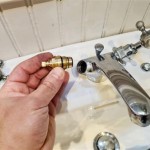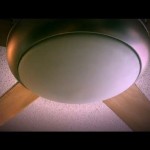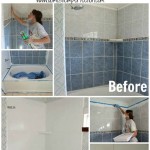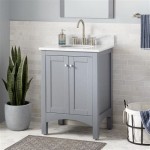What Pipe To Use For Bathroom Exhaust Fan
Proper ventilation is crucial for any bathroom to prevent moisture buildup, which can lead to mold, mildew, and structural damage. A key component of an effective ventilation system is the exhaust ductwork that carries moisture-laden air outside. Selecting the correct type of pipe for this purpose is essential for optimal performance and safety. This article discusses the various piping options available for bathroom exhaust fans and the factors influencing their selection.
Key Considerations for Choosing Exhaust Ducting
Several factors influence the choice of exhaust ducting, impacting the system's efficiency, longevity, and safety. Understanding these considerations is paramount for making an informed decision.
*
Material:
Different materials offer varying levels of durability, moisture resistance, and fire safety. *Diameter:
The duct diameter directly affects airflow and system performance. *Length and Number of Bends:
Long duct runs and multiple bends restrict airflow and reduce fan efficiency. *Insulation:
In colder climates, insulation prevents condensation and improves energy efficiency. *Local Building Codes:
Adherence to local building codes ensures safety and proper installation.Rigid Metal Ducting
Rigid metal ducting, typically made of galvanized steel or aluminum, is a popular choice for bathroom exhaust fans due to its durability and low resistance to airflow. It is also non-flammable, contributing to improved fire safety.
Types of Rigid Metal Ducting
*
Galvanized Steel:
Offers excellent strength and corrosion resistance, making it suitable for both interior and exterior applications. *Aluminum:
Lighter than galvanized steel and naturally corrosion-resistant, aluminum is easier to install and ideal for longer duct runs.Flexible Metal Ducting
Flexible metal ducting, often referred to as "flex duct," provides greater installation flexibility, particularly in tight spaces or around obstacles. It is constructed with a flexible aluminum core and covered with a plastic or foil-backed vapor barrier.
Advantages and Disadvantages of Flexible Metal Ducting
*
Advantages:
Ease of installation, maneuverability in confined areas. *Disadvantages:
Higher airflow resistance compared to rigid ducting, potential for kinks and bends that restrict airflow. Care should be taken during installation to maintain smooth curves and minimize airflow restrictions.PVC Piping
PVC (polyvinyl chloride) piping, while commonly used for plumbing, is generally not recommended for bathroom exhaust fans. Although moisture-resistant, PVC is flammable and can release toxic fumes when exposed to high temperatures.
Why PVC is Generally Unsuitable for Exhaust Ducting
*
Flammability:
PVC is a combustible material posing a fire hazard. *Toxic Fumes:
Burning PVC releases toxic gases that can be harmful if inhaled. *Temperature Sensitivity:
PVC can soften or deform at elevated temperatures.Choosing the Right Duct Diameter
The correct duct diameter is crucial for proper ventilation. Using a duct that is too small restricts airflow and reduces fan efficiency. Conversely, an oversized duct can lead to reduced air velocity and increased noise.
Determining the Appropriate Duct Size
*
Consult the Manufacturer's Instructions:
The exhaust fan manufacturer typically specifies the recommended duct diameter. *CFM Rating:
The fan's CFM (cubic feet per minute) rating determines the required duct size. Higher CFM ratings require larger diameter ducts. *Duct Length:
Longer duct runs may require a larger diameter to compensate for friction losses.Importance of Proper Installation
Even with the correct duct material and diameter, improper installation can significantly hinder ventilation system performance and create potential hazards.
Installation Best Practices
*
Minimize Bends and Turns:
Each bend or turn in the ductwork restricts airflow. Use smooth curves and minimize the number of bends whenever possible. *Seal All Joints:
Properly sealing all joints with duct tape or mastic prevents air leakage and ensures efficient operation. *Proper Slope:
For horizontal runs, maintain a slight slope towards the exterior to facilitate condensation drainage. *Insulation:
In colder climates, insulate the ductwork to prevent condensation and improve energy efficiency.Insulating Ductwork
Insulating the ductwork is especially important in colder climates where temperature differences between the inside and outside air can cause condensation to form inside the duct. This condensation can lead to moisture damage and reduced system efficiency.
Benefits of Duct Insulation
*
Prevents Condensation:
Insulation helps maintain the temperature of the exhaust air, minimizing condensation formation. *Improves Energy Efficiency:
Reduced condensation translates to less wasted energy. *Reduces Noise:
Insulation can help dampen noise from the exhaust fan.
Venting A Bath Fan In Cold Climate Fine Homebuilding

Installing A Bathroom Fan Fine Homebuilding

Bathroom Exhaust Fans Building America Solution Center

Blog

How To Size A Bathroom Exhaust Fan

How To Use An In Line Exhaust Fan Vent Two Bathrooms Diy Family Handyman

What Parts Do I Need To Install An Inline Fan In My Bathroom

Bathroom Extractor Fan Install Using Rigid Plastic Duct

Inspecting For Air Sealing At Kitchen And Bathroom Exhaust Fans Internachi

Why Does My Bathroom Ceiling Fan Drip Foothills Roofing Calgary
Related Posts







